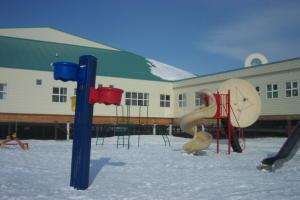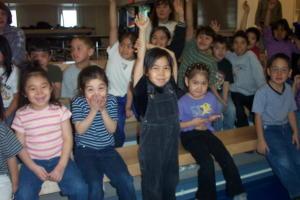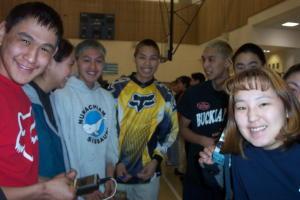1 April, 2002
We have traveled across 250 wilderness miles where
there were no signs of human civilization. There was
nothing but the snow upon the open tundra and rolling
hills. Since we left Council, our eyes have beheld
the Alaska wilderness. However, today we were
welcomed into the Native Alaskan village called
Buckland. It sits on the banks of the Buckland River
at the other end of the Seward Peninsula. It sits
quietly amongst the wilderness. Buckland is alone and
isolated. It's 500 mainly Native Alaskans are
situated and dependent upon each other for living.
There are no roads to Buckland. Buckland exists as a
tiny settlement amongst the grand Arctic terrain.
During winter the main means of transportation are
snowmachines since their life is dependent upon snow
for 7 months of the year. The other means of
transportation are four-wheelers to mainly go to
hunting and fishing sites. People do travel to the
neighboring village of Selawik for companionship and
the joy of visitation to another village. The main
mode of travel is airplane, which takes the people to
the larger places of civilization such as Nome and
Anchorage.
Life is simple in Buckland. The 500 people are
centered around the school, the community small store,
washeteria, a gas pump, and the small power plant. A
generator at the power plant that someone monitors
produces the electricity. The washeteria is where
people shower and wash clothes. It is connected to the
village water tank. Since Buckland has main water
areas surrounding the village, there is much fishing
in this area. The Alaskans also still perform
traditional whaling practices hunting the beluga
whale. The Native Alaskans are still connected deeply
to their native culture but are also very modernized.
This is evident in the Buckland School.
Buckland school is a newly built school and has
state-of-the-art equipment. There are 154 students
enrolled at the school for grades K-12. The
facilities are beautiful and modern. It is hard to
believe that the school sits amidst true wilderness.
The children learn all the subjects that are taught in
other United States schools. However, the native
Alaskan Inupiat language is still taught to the
children. The importance and connection of the
children to their native culture is passed on in the
schools.
We very much appreciated our overnight rest at the
school. The clean showers and a warm bed were in need.
Today we were able to put on a presentation for all
150 students from grades k-12 at the school.
SnowSTAR 2002 brought out all of the fancy scientific
equipment that is used to make snow measurements. The
students entered the gymnasium by grade groups. The
science equipment was set up on individual tables and
one member of the team monitored each table. The
students rotated from table to table and were able to
see the demonstration of the equipment. The student's
eyes were opened to a whole new world of snow. A
world of snow that they have lived in for their
lifetime but today they were opened to a new
dimension.
SnowSTAR 2002 would like to give special recognition
to Cheryl Jong's Earth Science class on their
measurements that were taken on the weather throughout
the year. They have been recording the daily
temperatures, newly fallen snow, total snow depth, and
wind direction. These measurements will be used to
map the weather patterns on our route.
WHERE IS MRS. CHEUVRONT????? LET'S PLOT!!!!!
Latitude: 66.25216 degrees North
Longitude: -160.72174 degrees west
HIGH TEMP: -3 degrees Celsius
LOW TEMP: -6 degrees Celsius
Our visit to Buckland was splendid and we all enjoyed
teaching and interacting with the children. However,
it felt good to be back on the move. As we traveled on
the wind blew in some fresh snow against our faces. A
small herd of caribou was spotted on the snow spotted
tundra. We stopped at two measurement sites along our
route today, and then traveled onward along a marked
trail north to our next village of Selawik. Tonight
we rest in a shelter cabin along the trail. Tomorrow
we move on.....

Buckland school serving grades K-12.

Buckland Elementary kids learning about snow science!

High School students learning cold science!

This young lady has been working with SnowSTAR 2002's meteorologist,Karl Volz from Anchorage on weather data.
Contact the TEA in the field at
.
If you cannot connect through your browser, copy the
TEA's e-mail address in the "To:" line of
your favorite e-mail package.
|
